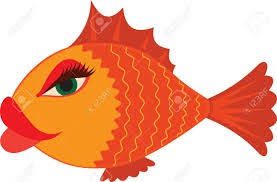Anatomy of Fishes: Female Fish and their Reproductive Strategies
Fish anatomy is the study of the form or morphology of fishes either for a male fish or female fish. It can be contrasted with fish physiology, which is the study of how the component parts of fish function together in the living fish.
In practice, fish anatomy and fish physiology complement each other, the former dealing with the structure of a fish, its organs or component parts and how they are put together, such as might be observed on the dissecting table or under the microscope, and the latter dealing with how those components function together in living fish.
The anatomy of fish is often shaped by the physical characteristics of water, the medium in which fish live. Water is much denser than air, holds a relatively small amount of dissolved oxygen, and absorbs more light than air does.
The body of a fish is divided into a head, trunk and tail, although the divisions between the three are not always externally visible. The skeleton, which forms the support structure inside the fish, is either made of cartilage, in cartilaginous fish, or bone in bony fish.
The main skeletal element is the vertebral column, composed of articulating vertebrae which are lightweight yet strong. The ribs attach to the spine and there are no limbs or limb girdles.
The main external features of the fish, the fins, are composed of either bony or soft spines called rays which, with the exception of the caudal fins, have no direct connection with the spine. They are supported by the muscles which compose the main part of the trunk.
The heart has two chambers and pumps the blood through the respiratory surfaces of the gills and on round the body in a single circulatory loop. The eyes are adapted for seeing underwater and have only local vision.
There is an inner ear but no external or middle ear. Low frequency vibrations are detected by the lateral line system of sense organs that run along the length of the sides of fish, and these respond to nearby movements and to changes in water pressure
Testes
Most male fish have two testes of similar size. In the case of sharks, the testes on the right side is usually larger. The primitive jawless fish have only a single testis, located in the midline of the body, although even this forms from the fusion of paired structures in the embryo.
Under a tough membranous shell, the tunica albuginea, the testis of some teleost fish, contains very fine coiled tubes called seminiferous tubules. The tubules are lined with a layer of cells (germ cells) that from puberty into old age, develop into sperm cells (also known as spermatozoa or male gametes).
The developing sperm travel through the seminiferous tubules to the rete testis located in the mediastinum testis, to the efferent ducts, and then to the epididymis where newly created sperm cells mature (see spermatogenesis).
The sperm move into the vas deferens, and are eventually expelled through the urethra and out of the urethral orifice through muscular contractions.
However, most fish do not possess seminiferous tubules. Instead, the sperm are produced in spherical structures called sperm ampullae. These are seasonal structures, releasing their contents during the breeding season, and then being reabsorbed by the body.
Before the next breeding season, new sperm ampullae begin to form and ripen. The ampullae are otherwise essentially identical to the seminiferous tubules in higher vertebrates, including the same range of cell types.
In terms of spermatogonia distribution, the structure of teleosts testes has two types: in the most common, spermatogonia occur all along the seminiferous tubules, while in Atherinomorph fish they are confined to the distal portion of these structures.
Fish can present cystic or semi-cystic spermatogenesis in relation to the release phase of germ cells in cysts to the seminiferous tubules lumen.
Read Also: List of Problems Confronting Livestock Production
Ovaries
Many of the features found in ovaries are common to all vertebrates, including the presence of follicular cells and tunica albuginea. There may be hundreds or even millions of fertile eggs present in the ovary of a female fish at any given time. Fresh eggs may be developing from the germinal epithelium throughout life.
Corpora lutea are found only in mammals, and in some elasmobranch fish; in other species, the remnants of the follicle are quickly resorbed by the ovary. The ovary of teleosts is often contains a hollow, lymph-filled space which opens into the oviduct, and into which the eggs are shed.
Most normal female fish have two ovaries. In some elasmobranchs, only the right ovary develops fully. In the primitive jawless fish, and some teleosts, there is only one ovary, formed by the fusion of the paired organs in the embryo.
Fish ovaries may be of three types: gymnovarian, secondary gymnovarian or cystovarian. In the first type, the oocytes are released directly into the coelomic cavity and then enter the ostium, then through the oviduct and are eliminated. Secondary gymnovarian ovaries shed ova into the coelom from which they go directly into the oviduct. In the third type, the oocytes are conveyed to the exterior through the oviduct.
Gymnovaries are the primitive condition found in lungfish, sturgeon, and bowfin. Cystovaries characterize most teleosts, where the ovary lumen has continuity with the oviduct. Secondary gymnovaries are found in salmonids and a few other teleosts.
Eggs
Salmon female fish eggs in different stages of development. In some only a few cells grow on top of the yolk, in the lower right the blood vessels surround the yolk and in the upper left the black eyes are visible.
The eggs of female fish and amphibians are jellylike. Cartilagenous fish (sharks, skates, rays, chimaeras) eggs are fertilized internally and exhibit a wide variety of both internal and external embryonic development. Most female fish species spawn eggs that are fertilized externally, typically with the male fish inseminating the eggs after the female fish lays them.
These eggs do not have a shell and would dry out in the air. Even air-breathing amphibians lay their eggs in water, or in protective foam as with the Coast foam-nest treefrog, Chiromantis xerampelina.
Read Also: The Concept of Animal Production on Agriculture
Intromittent organs
This young male spinner shark has claspers, a modification to the pelvic fins which also function as intromittent organs
Male cartilaginous fishes (sharks and rays), as well as the male fish of some live-bearing ray finned fishes, have fins that have been modified to function as intromittent organs, reproductive appendages which allow internal fertilization. In ray finned fish they are called gonopodiums or andropodiums, and in cartilaginous fish they are called claspers.
Gonopodia are found on the male fish of some species in the Anablepidae and Poeciliidae families. They are anal fins that have been modified to function as movable intromittent organs and are used to impregnate the female fish with milt during mating.
The third, fourth and fifth rays of the male fish anal fin are formed into a tube-like structure in which the sperm of the fish is ejected. When ready for mating, the gonopodium becomes erect and points forward towards the female fish.
The male fish shortly inserts the organ into the sex opening of the female fish, with hook-like adaptations that allow the fish to grip onto the female to ensure impregnation. If a female fish remains stationary and her partner contacts her vent with his gonopodium, she is fertilized. The sperm is preserved in the female fish’s oviduct. This allows the female fish to fertilize themselves at any time without further assistance from male fish.
In some species, the gonopodium may be half the total body length. Occasionally the fin is too long to be used, as in the “lyretail” breeds of Xiphophorus helleri. Hormone treated female fish’s may develop gonopodia. These are useless for breeding.
Similar organs with similar characteristics are found in other fishes, for example the andropodium in the Hemirhamphodon or in the Goodeidae.
Claspers are found on the male fish’s of cartilaginous fishes. They are the posterior part of the pelvic fins that have also been modified to function as intromittent organs, and are used to channel semen into the female fish’s cloaca during copulation.
The act of mating in sharks usually includes raising one of the claspers to allow water into a siphon through a specific orifice. The clasper is then inserted into the cloaca, where it opens like an umbrella to anchor its position. The siphon then begins to contract expelling water and sperm.
Physiology
Oogonia development in teleosts fish varies according to the group, and the determination of oogenesis dynamics allows the understanding of maturation and fertilisation processes. Changes in the nucleus, ooplasm, and the surrounding layers characterize the oocyte maturation process.
Postovulatory follicles are structures formed after oocyte release; they do not have endocrine function, present a wide irregular lumen, and are rapidly reabsorbed in a process involving the apoptosis of follicular cells.
A degenerative process called follicular atresia reabsorbs vitellogenic oocytes not spawned. This process can also occur, but less frequently, in oocytes in other development stages.
Some fish are hermaphrodites, having both testes and ovaries either at different phases in their life cycle or, as in hamlets, have them simultaneously.



